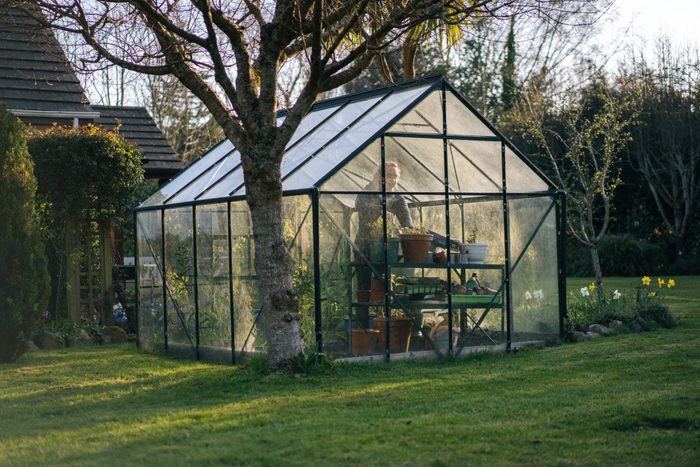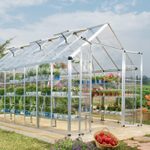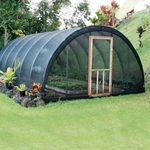How To Choose the Best Greenhouse Materials

Considering buying a greenhouse kit or building one from scratch? Expert Shelby DeVore has some advice to help you choose the best materials.
If you’re serious about a structure for all-weather growing, you’ll probably want something more sophisticated than the greenhouse I cobbled together (with help from friends) from old lumber and recycled sliding door panels. It works, but it’s rickety and develops a few more unintended ventilation openings with every passing year. It’s fine for the California Coast, but even though it’s covered with insulated glass, it wouldn’t offer much protection during a harsh Midwestern winter.
Climate is definitely an important consideration when choosing greenhouse coverings, says Shelby DeVore, founder of the Garden. Farm. Thrive. Academy. But it’s not the only consideration. The amount of light transmission is equally important, and that depends not just on how much sun you get, but also on what you’re growing.
“Different plants have different needs when it comes to growing,” she says. “Plants that produce a fruit, like tomatoes, have a higher need for light than plants that don’t produce a fruit, like lettuce.”
You also have a choice when it comes to frame materials, and this does matter. DeVore explains that, “Since the frame is literally the backbone of your greenhouse, you’ll want to use the best materials that you can. Replacing and repairing a frame could mean taking the entire greenhouse down and putting it back up.” Choosing the right frame and covering materials can make the difference between a structure that lasts 10 years and one that lasts only two.
On This Page
Choosing the Right Greenhouse Materials
A greenhouse frame has to be sturdy, of course, but it’s also helpful if it’s easy to assemble and offers some insulation value, especially if you live in a cold climate. Many ready-to-assemble greenhouse kits come with aluminum or wood frames. Galvanized steel is also common, and small, lightweight greenhouses often have PVC frames. DIYers routinely build frames from wood because it’s the easiest material to cut and fasten.
The covering is what actually protects plants from the elements while providing the light they need to grow. Fully transparent materials are best in places with limited sunlight, but they aren’t the best choice for every situation.
In areas with full sun, transparent materials encourage seedlings and young plants to reach upward and grow too tall before they have a chance to fill out. Moreover, a fully transparent covering can intensify sunlight to the point of scorching sensitive species. So, in some situations, a semi-transparent covering that diffuses sunlight creates a healthier growing environment.
A floor helps keep the greenhouse warmer and makes transporting plants and soil by wheelbarrow easier. It doesn’t necessarily need flooring, but if you opt for something other than soil, it needs to be waterproof, and it needs to drain well. Decking materials will work in a greenhouse.
What To Consider When Choosing Greenhouse Materials
When choosing greenhouse materials, you should take the following considerations into account:
- Climate: The amount of sunlight you get per day as well as the maximum and minimum temperatures when the greenhouse is in use determine the insulation value and the transparency of the covering material as well as the amount of ventilation you need.
- Weather: Not quite the same thing as climate, weather includes transient events such as high winds, snowstorms and hailstorms. A greenhouse in a location where these occur frequently needs a more durable covering.
- What you’re growing: If you’re growing tropical plants in a cold environment, you’ll need a thicker covering with more insulating value than if your main purpose for building the greenhouse is to start seeds early in the growing season.
- Cost: Some of the best covering materials can be very expensive. If you’re building a large greenhouse, you may have to economize by choosing a covering that’s almost as good as the best, but not quite.
- DIYability: When building your own greenhouse, it’s natural to look for frame and covering materials that you can cut and assemble yourself without the need for special equipment.
Best Greenhouse Frame Materials
Aluminum is DeVore’s top choice for a frame material, followed by wood. Galvanized steel and PVC are two other options to consider, because many greenhouse kits come with frames made from these materials.
- Aluminum: “Aluminum is going to last the longest and be the most durable,” says DeVore. It’s also lightweight and easy drill and to cut (you can cut it with a circular saw), but it conducts heat well, so it won’t help with insulation.
- Wood: The go-to option for most DIYers, wood is easy to work and helps insulate. DeVore warns, however, that the humid interior of a greenhouse can be hard on wood.
- Galvanized steel: Less expensive than aluminum and just as durable but a bit heavier. It does have a tendency to rust, but it takes many years for that to happen. It’s more difficult to cut than aluminum, usually requiring a grinder or hacksaw.
- PVC: PVC plastic doesn’t have much structural strength, so it’s appropriate only for very small greenhouses.
Best Greenhouse Covering Materials
Glass will always be a viable covering material, but it’s far less common than clear or semi-clear plastic, and we aren’t talking about construction or painter’s plastic. DeVore says that’s a terrible choice because it blocks light and doesn’t last. The best plastic coverings include:
- Polyethylene: The most common and cost-efficient material, polyethylene is durable and has great light transmission. Woven polyethylene cloth is preferred for windy areas. DeVore warns that polyethylene can’t be used with an unprimed PVC frame, because it deteriorates when in contact with PVC.
- Polycarbonate: Also a good choice, polycarbonate is almost as transparent as glass. It comes in flexible or rigid sheets and can be used on any style of greenhouse.
- Polyvinyl carbonate: Very durable and transparent, polyvinyl carbonate is great for windy areas, as well as for those that experience heavy snow and hailstorms, but it’s more expensive than other materials.
Best Greenhouse Flooring Materials
If you don’t want to put much energy into the floor, you can either leave the ground uncovered or spread mulch. That won’t help with insulation, and mulch can harbor fungi and bacteria. Better options include:
- Concrete: Easy to clean, drains water and helps with insulation.
- Vinyl tiles: Increasingly common in greenhouses, vinyl tiles are easy to install, waterproof and sanitary.
- Crushed stone and gravel: Easy to install, inexpensive, well-draining and, when overlaid with weed cloth, comfortable to walk on.



